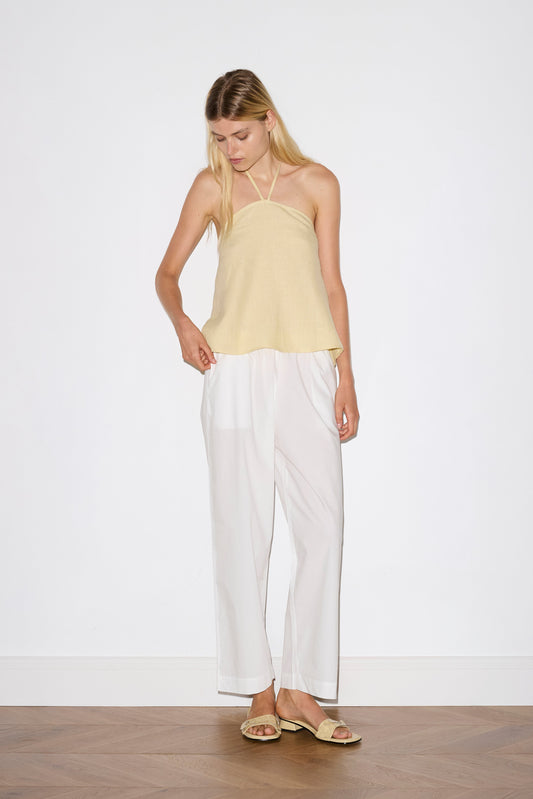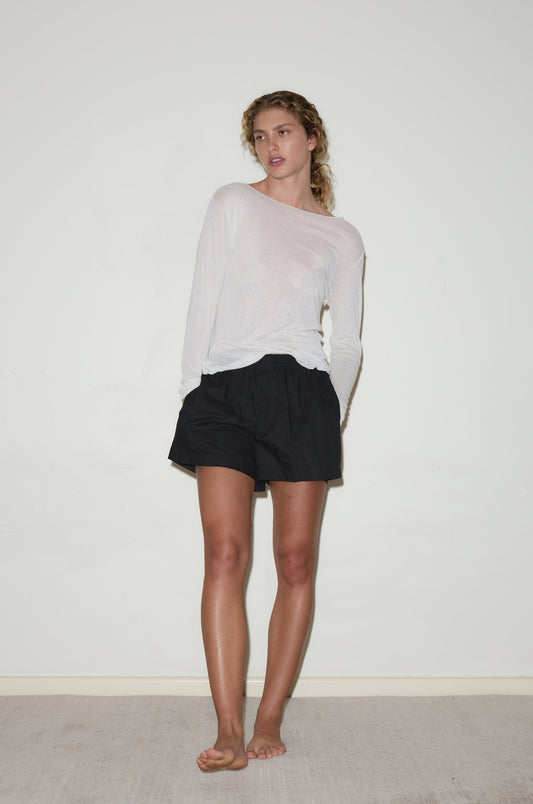WOMEN OF NOTE:
Zhu Ohmu | Ceramic Artist
Above anything else, Zhu Ohmu embraces imperfection. The Melbourne-based artist is known for her handcrafted otherworldly ceramic vessels that see undulating forms balance precariously atop one another, folding and twisting at the exact moments you might think they would fall away. Somehow, Zhu’s work defies the nature of gravity — along with the general expectation of ceramic vessels to be flawlessly resolved things. The artist’s unique approach to handbuilding clay has garnered widespread attention in the worlds of art and interiors, leading her to be represented by Sydney-based gallery Sally Dan-Cuthbert and debut a series of well received solo shows. What initially began as making homes for her plants is now an everyday practice for Zhu, who shares with us here more about herself and her beautiful vessels.
Location: Melbourne
Date: 21/8/20 Time: 8.00pm
|
Where are you from and where are you now? I was born in Taipei, Taiwan and grew up in Auckland, New Zealand. I’m currently based in Melbourne, Australia and I have been living here for 8 years.
Can you tell us a little about your home, what is the view like? My home is my sanctuary, I have lived here for nearly 4 years and I’m very lucky to spend lockdown in a space I love so much. The unit was built in 1991, a friend described the architectural style as ‘Miami neo-deco’. The most distinguishing features of the building are the curves constructed of glass bricks, and the buoyant yet calm energy that comes with so much natural light. The interior is very mid-century modern, with lots of teak furniture and indoor plants. There is a pink beehive in the small garden, and the name of my home is Casa de Abejas, which is Spanish for ‘House of Bees’. Every day I wake up to the view of many shades of green – a giant gum tree, billowing pepper trees, olive trees, a fig tree and a cherry blossom tree. Sometimes I see my elderly Italian neighbour John pottering around in his concrete garden. The windows of my housemates’ rooms face the opposite direction, and they enjoy the view of rooftops, rainbows, full moons and occasional visits from possums.
Are you a morning or evening person? I am a natural night owl trying to be a morning person.
You’re a practicing artist who makes beautiful ceramics, what initially drew you to work with clay in your art practice? I have a background in drawing and painting in art school, but I started playing with clay a couple of years after I graduated, initially to make planters for my plants.
You’re also a beekeeper, how did you come to work with bees? I started beekeeping in 2015 with Nic Dowse who is the founder of Honey Fingers Collective. The pink beehive in my garden is a collaboration between Nic, myself and Tilly Glascodine. Honey Fingers Collective is both a creative pursuit and a way to contribute to our urban ecology. Bees play an important part in the life cycle of plants and there’s an argument that bees can thrive better in the city than in the wild because of the consistent diversity of plants in people’s gardens. I find this really interesting as I am curious about the symbiotic relationship between ‘nature’ and the urban environment.
The vessels you make appear to defy gravity itself, they droop and twist and coil towards the sky, somehow remaining intact. What is your creative process like in creating these works? How did you discover this technique? The coil vessels emulate the mechanized process of 3D printing, but are made by hand. By inverting biomimicry, a concept where new technological innovations are discovered through the imitation of designs found in nature, this subversive gesture explores how we can remain relevant in the age of automation, where there are apprehensions of machines instigating human obsolescence. 3D-printed ceramics are made by stacking clay coils according to programmed measurements until the piece is completed. A computer software and a robotic arm control the nozzle that extrudes the clay, a technological innovation allowing complex ceramic designs to be printed quickly, accurately and in large numbers. Starting with the simple exercise of copying the way the 3D printer repeatedly performs the action of laying extruded coils one atop the other by hand, but without any preliminary planning, ceramic vessels emerged intuitively – droopy, lopsided- the forms seems to ebb and flow in the manner in which they are made. Dictated by the weight of moist clay, these pots are often pushed to their structural limits, and many have collapsed. Unlike the machine, I am able to detect the slightest change in the properties of the clay body under different environmental conditions. This insight into plasticity and workability, which can only be obtained by spending time with the physical matter through play and observation, allows compromise with the material. The artist’s hands are able to build forms that the present day ceramic 3D printer cannot, and this is because humans are capable of the patience, care and inquisitiveness needed for an intimate relationship with clay.
|
 |
 |
My lack of training in ceramics emphasizes the experimentation in the self-formulated coiling process. Breakages are very common in my works in my first year of making coil pots – the technique and precarious structures often lead to cracks or the entire vessel caving in, and this can occur anytime during the making, drying or firing stage. Disheartened that I could hardly produce one piece without faults, and also not wanting to discard these ‘failures’ I’ve spent many many hours on, the only option is to come to terms with the nature of the material and process. The Japanese philosophy of wabi-sabi resonated with this feeling of radical acceptance through and through. Wabi-sabi embraces the transience and imperfections of things- its aesthetic values take pleasure in the perverse beauty of the irregular, the torn, the fractured, the decayed... wholly accepting these qualities as part of the object’s history and story. It is a worldview where the considerations of beauty contrasted to the Western ideals of grandness and flawlessness; contrasted to the current throw-away culture where disposables are favoured over durable goods that can be repaired. I think wabi-sabi can teach us to tread lightly on this earth, and challenge us to step out of consumerist thought.
Your solo exhibition If not you, who? If not now, when? was due to open at Sydney-based gallery Gallery Sally Dan-Cuthbert where you’re represented on June 9th, the same night that the borders between New South Wales and Victoria closed. How are you coping with this shift and what is this new body of work about? To be honest it was pretty stressful at the time. My best friend Lili was going to drive us to Sydney with the works but the COVID cases kept rising in Melbourne, and the restrictions and advice kept changing so quickly. But postponing the exhibition is the best decision. The titles of the ceramic pieces in If not you, who? If not now, when? are appropriated from climate rally protest signs of today’s youth, juxtaposed with news headlines regarding nature during the COVID19 pandemic. The intention is to provide an alternative platform for young voices of environmental activism beyond the space of public demonstrations, and inviting contemplation on our current realities and possible futures.
As Melbourne enters lockdown again, how are you planning to spend your time at home? I’m fortunate to be working from home 4 days a week for my day job, and have art projects lined up until 2022. Aside from work and art, I’ve also been cooking a lot more. Each week my housemate and I surprise each other with a new dish we’ve never made before.
Is there a particular part of your home that you love most? If so, why? That’s very hard to choose! I love the kitchen, I love the living and dining area, I love my bedroom, I love the stairwell, I love my garage studio... but if I really have to pick it will be the bathroom- for the bathtub, rain showerhead and beautiful afternoon light.
What are you currently reading and listening to? I’ve been reading about intersectional environmentalism and listening to Lili’s music Squaring Circles.
How do you stay grounded? Apart from writing to do lists and cleaning, consciously engaging my body with simple nourishing sensory exercises, especially of touch and smell, keeps me in the here and now. Combing my hair, stretching, drying brushing, face steaming, burning palo santo, touching myself, etc. |
|
What do you do to unwind? A siesta or a bath with lavender oil and Epsom salt. Has there been a significant moment of your past that has informed where you are today? In 2016 I was at an End of Beekeeping season Honey party at Nic’s home and met Lisa Marie Corso, who at the time wrote for The Design Files, and I was about to exhibit the Plantsukuroi series. The coiled vessels captured the attention of the interior design industry here and abroad after my feature on The Design Files, and have since gained traction in the worlds of craft, fine arts and most recently fashion. It’s really cool. What do you dream of while you sleep? I have been dreaming of my mother a lot lately, maybe because I miss her a lot and I’m not sure when I can see her next. |
 |
Interviewed by Chloe Borich for Deiji Studio’s Field Notes




